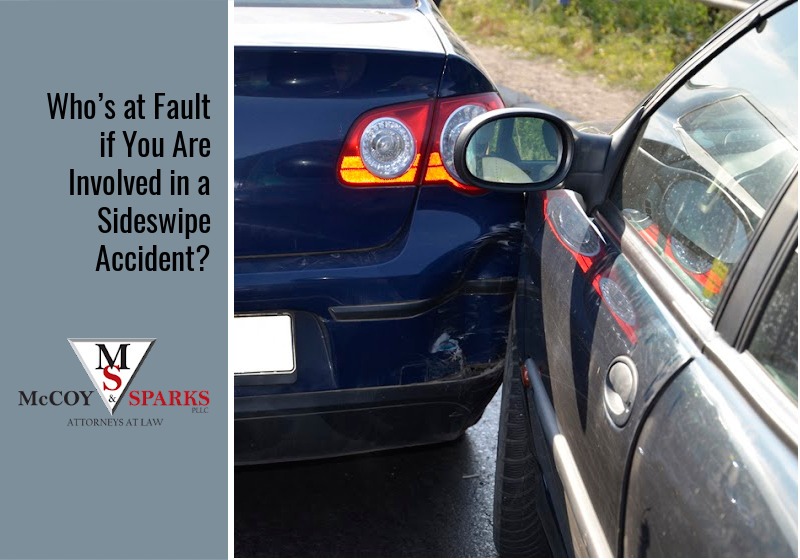
Who’s At Fault In A Sideswipe Accident?
A sideswipe accident is what happens when one car crosses into another driver’s lane to bump into or slide along the side of the other vehicle. Although there are cases where the damage could be minor — a long scratch or a dent — there are many cases where the initial sideswipe causes one or both drivers to lose control of their vehicles and cause a serious multi-car collision. Sideswipes can cause rollover accidents, particularly when they happen at high rates of speed, such as on the highway.
Nationally, failure to keep in the proper lane is cited as the cause of 6.6% of all fatal collisions in 2019, according to the Insurance Information Institute.
In Kentucky, sideswipe collisions (both meeting and passing) reflected 20% of all collisions and 4% of fatal collisions in 2019, according to the Kentucky State Police.
Who is at fault in a sideswipe accident?
Generally speaking, the driver of the vehicle that drifted or merged without checking properly first is in the wrong. The driver of the car who stays in his or her own lane is rarely to blame.
There are several causes of sideswipe accidents:
- A driver may try to merge or change lanes without noticing another vehicle in his blind spot.
- A distracted driver may drift into the lane next to him because he is fatigued, looking at a phone, or eating.
- A driver may lose effective spatial awareness because of being under the influence of alcohol or drugs.
- One driver may have tried to overtake but without leaving sufficient clearance between cars.
- A driver may try to turn right from the middle lane, swiping a car in the right-hand turn lane.
- A car may have a mechanical difficulty, such as faulty brakes or steering.
- Two cars may pass each other in opposite directions, but without leaving enough room between their vehicles. (It is interesting to note that the most common type of car crash in Kentucky takes place on a rural two-lane highway with no median.)
In the first five cases, the drifting driver is clearly in the wrong.
In the next example, the faulty car’s manufacturer or repair shop could be found liable.
However, what about the last example, when the cars are heading in opposite directions? How do you prove which car was closest to the line — or crossing the line? What about the many rural roads where there are no lines to mark the center? Which driver was negligent? Or — were perhaps both drivers negligent?
Kentucky is a no-fault state, so your insurance will pay for your injuries and damage. However, you may wish to consult an experienced auto accident attorney if you have been in a sideswipe collision and feel that the other driver was at fault.
After an accident, you are allowed to sue the other driver if the medical cost of injuries amounts to more than $1,000. Given the fact that the average emergency room visit costs $1,500 before scans, tests, and medications (or admittance) are factored in, having medical costs that top $1,000 after an injury-causing crash is highly likely.
How can you avoid sideswipe accidents?
You can’t control the behavior of other drivers, so there is nothing you can do to guarantee your safety 100%, but you can certainly lessen the risk.
- Be aware of your surroundings. If you see a car behind you speeding and weaving between vehicles, try to avoid it — or at least be prepared to swerve.
- Always know what cars are in your blind spot. Double-check before you change lanes or overtake.
- Use your side mirrors.
- Understand that large trucks have huge blind spots on all four sides. Unfortunately, when a truck driver makes a lane change, he or she runs the risk of colliding with another vehicle that they didn’t see or of running a car off the road. Don’t put yourself in the situation of being in that other car.
- If you are thinking of buying a new vehicle, consider one of the many new models with warning systems:
- Blindspot monitoring works by having sensors mounted on side mirrors to give an audible or visible alert if a vehicle is detected in an adjacent lane.
- Lane departure warning systems (LDW) are designed to keep you in your lane; they give warnings to alert you when your car approaches or crosses lane markings. The warning may be a light, a chime or beep, or even a vibration of the steering wheel or seat.
What should you do if you are in a sideswipe accident?
As you are hit, do your best to control your car and stay in your lane. Do not overcorrect if you can avoid it.
After the collision has occurred, follow all of the steps you would take after any collision:
- Stay calm and call the police
- Get the name, phone, and contact information of the insurance company of the other driver(s)
- Make a note of the color, make, and model of the other vehicle(s)
- Make a note of the location of the accident, including any side streets
- Take a photograph or draw a diagram of the accident scene and any property damage
- Get the name of any police officers on the scene
- Get the name and phone numbers of any passengers and/or witnesses
- Seek medical care
- Notify your insurance company
- File an accident report
- Contact our Central Kentucky car accident attorneys at McCoy & Sparks, PLLC to determine if you can file a claim
After a sideswipe auto accident where you were injured, please contact McCoy & Sparksfor a free and confidential consultation. We’ll ask questions about your situation and help you understand what to do next. Come meet with us. We’ll try hard to make you glad that you did.
NO FEE UNLESS YOU WIN
1-844-4KY-WINS

